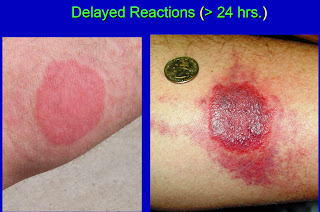Bed bugs and MRSA
Question: If
bedbugs don’t transmit disease, how come there are cases of people developing MRSA as a result of bed bug bites?
Answer: Bed bugs do not transmit MRSA. Although there have been reports of persons developing methicillin resistant Staphylococcus aureus (MRSA) infections, such as boils or abscesses associated with bed bug bites, it turns out the bed bugs really weren’t directly at fault. Rather, the cases of MRSA infections associated with bed bug bites are actually an example of scratching leading to minor skin trauma and subsequent secondary bacterial infections. In these cases, people who are carriers of MRSA scratch at the itchy bite sites and provide a port of entry for the MRSA (which was already present on their skin) to get in and under the skin and cause the secondary infection. The bed bug can be blamed for the itch, but not for the infection.
Thought Bedbugs Were Bad? Try Bedbugs with MRSA
The one bright side to having bedbugs - if you wanted to be optimistic about it - has always been that at least the tormenting critters didn't transmit disease. But now researchers in Vancouver report that they've found bedbugs with methicillin-resistant Staphylococcus aureus, or MRSA.
The scientists studied five bedbugs, taken from three patients treated at St. Paul's Hospital. All three patients were residents of Vancouver's poor Downtown Eastside, where both bedbugs and MRSA have been on the rise in recent years. The researchers wanted to see if there was a connection.
So they crushed and analyzed the bugs and found three samples with MRSA, the superbug that is resistant to most commonly used antibiotics. The two other samples had vancomycin-resistant Enterococcus faecium, or VRE, a less dangerous antibiotic-resistant bacteria.
That's pretty much all they know at this point. It's not clear, for example, whether the drug-resistant germs were transmitted from people to bedbugs, or the other way around. The strain of MRSA the scientists found was consistent with community-associated MRSA found in other Downtown Eastside residents.
It's also not clear whether the bacteria existed on the bedbugs or in them. That is, were the bedbugs carrying MRSA on their backs, or were the bacteria living and growing inside them? Either way, it's bad news: if bedbugs are capable of carrying and transmitting MRSA the way a mosquito spreads malaria, it could mean a whole new vector of human disease.
"To the best of my knowledge, we have not seen any research that has proven bedbugs have been able to pass diseases to their human hosts," says Gail Getty, a research entomologist at the University of California, Berkeley, who specializes in urban pests. "Although they do carry pathogens, there is no single scientific study that has proven a transfer." (Past data show that the hepatitis B virus can survive in bedbugs for six weeks after feeding, but there is no evidence that the bugs are able to transmit disease.)
If, on the other hand, bedbugs simply carry MRSA the way an airplane tray table does, it's less troubling but still significant: bedbugs could still spread the germ from person to person, especially in close-quartered living situations like homeless shelters; the bacteria can survive on surfaces for hours or even days under the right conditions.
"Even though this is a small study, it suggests that bedbugs may be playing a role in the transmission of MRSA in inner-city populations where bedbug infestations are a problem," said Marc Romney, one of the study's authors and the medical director of infection prevention and control at St. Paul's Hospital.
Since MRSA enters the bloodstream through open wounds or cuts, it's technically possible that if an infected bedbug were to find its way onto an infested person - with the telltale itchy welts and broken skin from scratching - it could pass on the bacteria.
"I've been predicting this for years," says entomologist Dr. Michael F. Potter, a professor at the University of Kentucky, in an e-mail, "seeing how all it takes is a breakage of the skin for infection."
If left untreated, MRSA can cause pneumonia or infections of the skin, blood and joints. The bacteria, once confined to hospitals, has been increasingly found in community settings like locker rooms and gyms, and kills 19,000 Americans each year. Recently, the FDA approved a quick diagnostic test that promises to help infected patients receive treatment more quickly.
The peer-reviewed paper was published in the Centers for Disease Control and Prevention's Emerging Diseases Journal.
http://www.pestworld.org/all-things-bed-bugs/bed-bug-news/news/thought-bedbugs-were-bad-try-bedbugs-with-mrsa/



